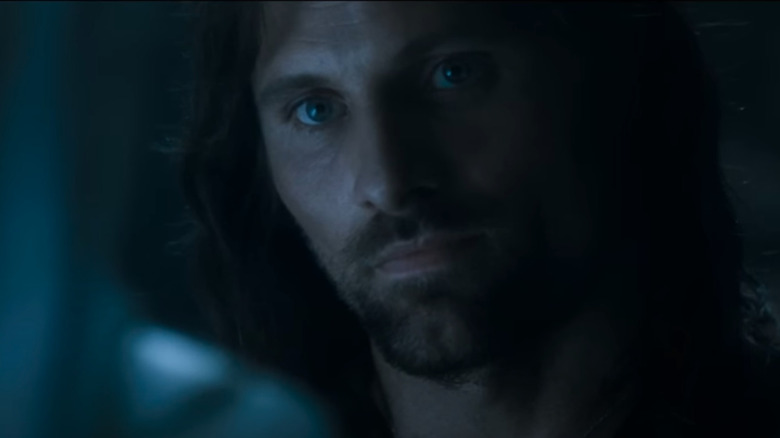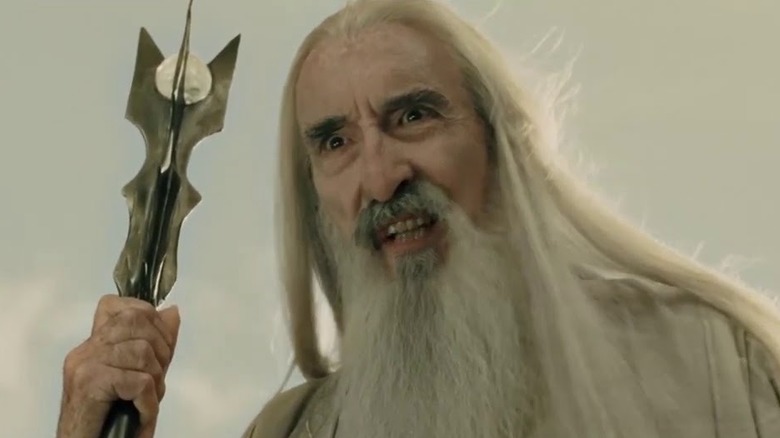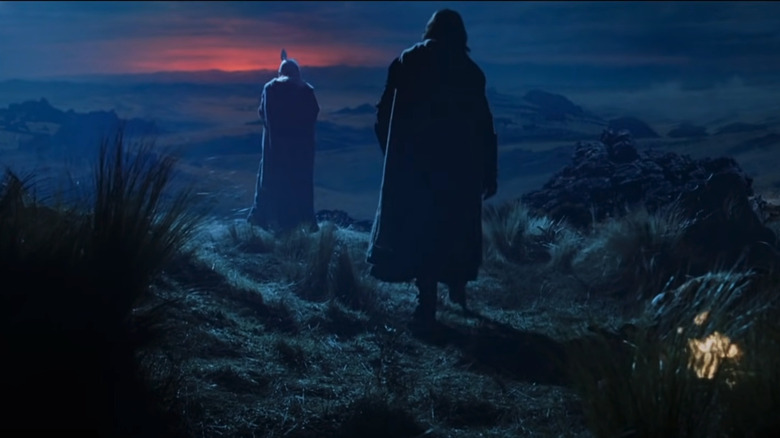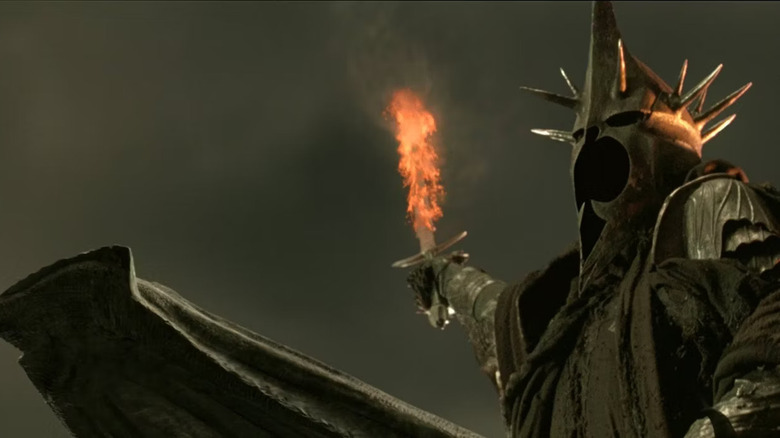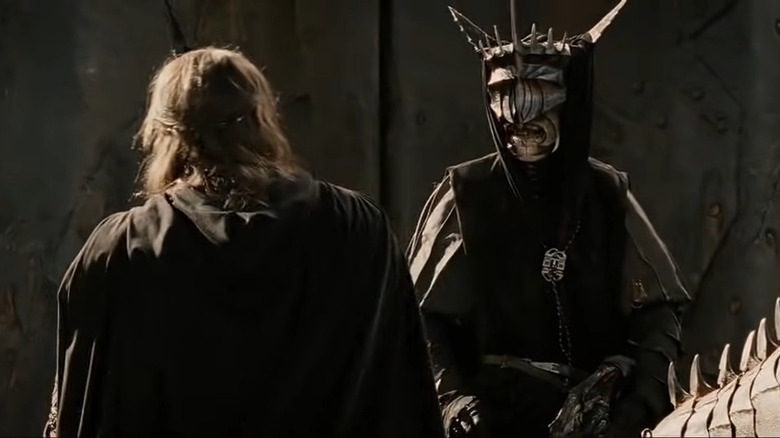Lord Of The Rings: 5 Extended Scenes That Changed Everything
Peter Jackson’s re-released “The Lord of the Rings” trilogy is the extended experience to rule them all. The total runtimes for the extended versions clock in at a grand total of 726 minutes — that’s over 12 hours. The best part? 168 minutes consists of brand-new footage. Peter Jackson didn’t consider these gargantuan installments the definitive version of his trilogy, but they’ve captivated the hearts of Tolkien fandom for decades, so much so that some are even petitioning for a mythic-sized “Mithril Edition” cut of Peter Jackson’s epic trilogy.
Some of this new footage comes from expanded versions of scenes already in the theatrical releases. Other sections are never-seen-before segments that were cut during the original edit. Of this latter category, some are fun, colorful additions that embellish the story. The “Concerning Hobbits” sequence at the beginning of “The Fellowship of the Ring” extended edition, for example, provides some interesting background on the Halfling folk. The “Fangorn Comes to Helm’s Deep” scene from “The Two Towers” extended edition helps explain where Saruman’s defeated army goes after the Battle of Helm’s Deep.
Some added scenes go further, changing the entire viewing experience. Let’s look at five of these and consider how they alter the course of the trilogy as a whole. Just for clarity, we’ll only be considering completely new scenes, not extended original scenes. That means, for instance, the powerful scene when Éomer finds his presumed dead sister during the Battle of the Pelennor (which is instrumental in the books) won’t make the cut, since it’s added onto a pre-existing sequence.
Gilraen’s Memorial scene shifts Aragorn’s character arc
Our first candidate is a quiet, unassuming scene in “The Fellowship of the Ring” extended edition. It takes place in Rivendell when Strider the Ranger is shown visiting the memorial of his mother, Gilraen. Elrond shows up, reminding him that while the Elves can reforge Aragorn’s sword (turning it into Andúril in the process), the High Elves don’t have the power to wield this sword of kings. Aragorn responds by saying, “I do not want that power. I have never wanted it.” Elrond tells Aragorn (and the audience) that he is the last of the bloodline, there’s no one else, etc.
The exposition is obviously important here, but the real game changer is Aragorn’s deliberate declaration that he doesn’t want to be the king of Gondor. This posture will eventually shift once he realizes that it is his destiny to sit on the throne. What this added scene does, though, is make Aragorn a reluctant leader forced into the spotlight. It’s a relatable angle and one that is more implied than stated in the theatrical cut.
It’s also not in line with the source material. In Tolkien’s writings, Aragorn is a confident king in exile. He knows his calling and is merely biding his time, patiently watching and waiting for the right time to come out of hiding. By adding this scene, Peter Jackson officially breaks from the books. (It’s not the only change Jackson made that Tolkien would have hated.)
The Voice of Saruman scene brings critical closure
One of the most memorable added scenes in “The Return of the King” extended edition comes right at the beginning. This features a much longer sequence in the flooded and Ent-trashed circle of Isengard. It also depicts the vocal confrontation between Saruman and several of our heroes — primarily Gandalf and Théoden.
This confrontation is a major part of the source material, and while it alters Saruman’s book ending (spoiler alert: he doesn’t fall off of Orthanc and get skewered), the scene provides some much-needed resolution for the fallen wizard. The entire Saruman kerfuffle is an even bigger deal in the books, and the extended edition sets the stage for Aragorn’s later added scene where he confronts Sauron via the magical live-streaming orb with Andúril in hand. It also shows what happens to Gríma Wormtongue and explains why Pippin finds one of the rare and valuable Seeing Stones called the Palantíri just lying there, glowing in the water.
The inclusion of the “Voice of Saruman” scene also changes things outside of the story itself. When Christopher Lee found out that the sequence had originally been cut (and thus his only appearance in “The Return of the King” movie), the disgruntled Saruman actor opted to skip the premiere. If only the extended version had come out in theaters, perhaps we would have seen Lee headed to a cinema to take in the Oscar-winning experience on the big screen.
The Heir of Númenor scene sets Aragorn’s career trajectory in motion
It’s easy to understand why this next scene was cut. It is a two-minute chunk in “The Two Towers” extended edition that consists of Gandalf monologuing and Aragorn staring at him in the dim dark of the fields of Rohan. Gandalf kicks things off by explaining that Sauron knows the heir of Númenor (i.e., Aragorn) is alive and well. He points out that the Dark Lord fears this fact and it will spur him to use his new ally, Saruman, to strike hard and fast. This will set up the struggle in Rohan and the first stage of the War of the Ring.
While overwhelming, dry, and dimly lit, the scene is a critical piece in understanding the larger story of the trilogy. For those who haven’t read the books, it helps establish the fact that Aragorn’s existence isn’t just a convenient way to fill the leadership vacuum in Gondor. He is the mortal heir of a line of kings that have troubled Sauron for thousands of years.
Other similar extended edition scenes help fill this gap. The “Decline of Gondor” scene, for instance, is another added Gandalf exposition sequence where the White Wizard tells the audience (through Pippin this time) about the history of Gondor and why it’s so weak at the moment. In comparison, the “Heir of Númenor” scene stands out simply because it efficiently raises the stakes for the remaining story.
The Witch-king’s Hour rewrites the power dynamic in Middle-earth
“The Witch-king’s Hour” is a short but powerful deleted scene added to “The Return of the King” extended edition. It depicts a confrontation between the Witch-king of Angmar and Gandalf in the broken circles of Minas Tirith right before the Battle of the Pelennor Fields. The antagonist is on his fell beast while Gandalf is riding Shadowfax with Pippin behind him. In the scene, Gandalf tells off the Witch-king, who replies, “Do you not know death when you see it, old man? This is my hour.” At this point, he uses his flaming sword to destroy Gandalf’s staff magically. He gloats to Gandalf that he has failed and the World of Men will fall, but then — hey presto! — he’s interrupted by the arrival of the Rohirrim and has to scuttle off to the battle.
The scene completely changes the tone between Gandalf and the Nazgûl. In the books, Gandalf is much more powerful than the Nine. In the Minas Tirith confrontation in the books, both Gandalf and Shadowfax stoically resist the Witch-king and survive the encounter, staff intact.
Including it in the extended version sends the message that Gandalf can’t resist the leader of the Nazgûl on his own. It positions them as equals, even though Gandalf is a powerful angelic spirit, and the Black Rider is simply a Man. Yes, he’s a man with a magical ring, but if you know what the Rings of Power actually do in “The Lord of the Rings,” it doesn’t take much to realize that Gandalf is the overpowered option in every one-on-one scenario.
The Mouth of Sauron scene detracts from Aragorn
The last extended scene that genuinely changes the story comes at the end of “The Return of the King.” In the theatrical version, the armies of the West arrive at the Black Gate, where they are immediately attacked by overwhelming force. In the extended edition, we get a two-and-a-half-minute added scene where a character called the Mouth of Sauron comes out for an insulting round of diplomacy before the battle kicks off. He shows off Frodo’s mithril shirt and engages in some mocking discourse before a fed-up Aragorn cuts his head off in one stroke.
Technically, this helps complete the story since the Mouth of Sauron scene is in the book. But rather than being unceremoniously decapitated, the diplomat flees in terror when Gandalf, in one action, physically seizes the mithril shirt and verbally rejects Sauron’s terms for their surrender. The text in the book reads, “He looked at the fell faces of the Captains and their deadly eyes, and fear overcame his wrath. He gave a great cry and turned, leaped on his steed, and with his company galloped madly back to Cirith Gorgor.”
That’s all we see of him. Once again, the biggest change here has to do with Aragorn. Having the new king kill a diplomat without warning in frustration is a very un-Aragorn move. Even villains typically respect the neutrality of a negotiator. The event leaves a bit of a bad taste, and as fun as the Mouth of Sauron inclusion is for book fans, it’s probably best that this one got the axe.



